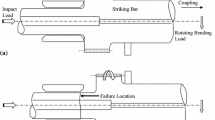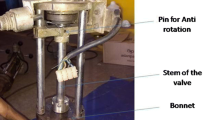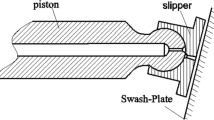Abstract
In this paper, bearing failure was reported for a needle roller bearing used as intermediate support in a pinion shaft system. Severe deformation and wear were noticed on the working surface of the failed needle roller and around the window lintel of the bearing cage. The geometry, materials and hardness of the failed needle roller bearing were analyzed. Appearance detection, SEM and EDS analyses were carried out for clarifying the potential reasons of the needle roller bearing failure. The effect of radial displacement, Hertz contact stress and misalignment on the service life of the needle roller bearing were discussed. The excessive deformation and misalignment, resulting from the unbalanced loading and improper assembly, are the likely cause of the needle roller bearing failure.
Similar content being viewed by others
Avoid common mistakes on your manuscript.
Introduction
Needle roller bearings (NRBs), possessing the advantage of excellent conservation of radial space, are widely used in rotational components of industrial machinery. In practice, most problems associated with the rotational components in industrial machinery are caused by, or associated with, roller bearing failures. It is therefore necessary to ensure that bearing failure modes and causes are well understood to improve the service life of roller bearings.
Many studies have been carried out on influence factors of the operational characteristics and service lives of NRBs or roller bearings. Ufezelsk et al. [1] analytically and experimentally investigated the axial forces generated by needle skew in full complement, continuous rotation needle bearings. Iqbal et al. [2] studied the frictional power loss of a solid-grease-lubricated NRB. Sukuzi et al. [3] investigated the torque loss of NRBs by use of a multibody dynamics model. Liu et al. [4] developed an analytical method for calculating the friction torque of a NRB with the roundness error. Maruyama et al. [5] developed the electrical impedance method that can simultaneously measure the thickness and breakdown ratio of oil films in elastohydrodynamic line contacts within thrust NRBs. Gong et al. [6] found that three-body abrasive wear was the main failure mode for the inner ring raceway of roller bearing in a wind turbine gearbox. Kumar and Satapathy [7] reviewed the typical distress, causes and diagnosis of bearings, including NRBs, in aerospace application.
In this study, a needle roller bearing, used as intermediate support for a pinion shaft of a megawatt reciprocating pump used in an underground coal mine, failed at the early stage of its service life, as shown in Fig. 1. The geometry, materials, and hardness for the failed NBR were analyzed. Appearance detection, SEM and EDS analyses were performed for increasing the understandings of the potential reasons for the NBR failure. The effect of radial displacement, Hertz contact stress and misalignment on the service life of the NRB is discussed.
Structure and Mechanics Analysis
As shown in Fig. 2, the pinion shaft system has two symmetrical helical gears and four roller bearings, i.e., two cylindrical roller bearings and two needle roller bearings, used as four supports. Two cylindrical roller bearings are laid out on the two ends of the pinion shaft, and two needle roller bearings are positioned in the middle of the two helical gears. The type of the needle roller bearings is NA4848. For the pinion shaft, the input power is 1Mw and the rated rotational speed is 1500 rpm.
The loading analyses for the pinion shaft system were carried out, by use of the commercial code, KISSsoft [8]. The deflection and force along with the length of the pinion shaft can be obtained in Fig. 3. The radial loading, Fr, can also be obtained by the KISSsoft software, with a value of 17.2kN.
Experimental Failure Analysis and Results
Geometry, Material and Hardness
The NA4848 NBR has an outer diameter, D, of 300 mm, an inner diameter, d, of 240 mm and a width, B, of 60 mm. The NA4848 NBR includes 58 rollers, which have a diameter, Dr, of 10 mm and a length of 48 mm. The convexity of the needle roller, cmax, was tested by a profilometer, in a value of about 9 mm, as shown in Fig. 4. The initial radial clearances of several new NA4848 NBRs, Pd, were measured by a bearing clearance measuring instrument, which are in a range of 0.12–0.15 mm.
The materials of the outer ring, inner ring, cage, and rollers of the NA4848 were also tested. The chemical compositions of the NA4848 components are shown in Table 1. The components of the NA4848 NBR are made of high carbon chromium bearing steel. The hardness of the outer ring, inner ring and needle rollers was 61, 62 and 64 HRC, respectively. The hardness results of NA4848 NBR components are in accordance with ISO 683/17[9] requirements.
Appearance Detection of Failed NBR
Figure 5 shows the appearance of the failed needle rollers. Scratches can be observed in the circumferential direction on the working surface of the needle roller and long dents can be detected in the axial direction on the working surface of the needle roller, as can be seen in Fig. 5a. Brinelling damage on the working surface adjacent to one end surface of the failed needle roller are shown in Fig. 5b, which indicates overloading, or impact loading occurs[10]. It can be seen in Fig. 5c, one end surface of the failed needle roller was deformed and worn-out.
It can be seen in Fig. 6, wear marks appeared on the lintels of the inner diameter surface, both sides of the outer diameter surface and the local lintels of the outer diameter surface of the broken cage. There are also wear marks on the surface of the window lintels, which are distributed in areas of the lintel surfaces, and these areas are curled, as can be seen in Fig. 7.
SEM Morphology and EDS Analyses
SEM analysis was performed on the worn surface of a failed needle roller. Severe adhesive wear occurred on the worn surface of the needle roller, as shown in Fig. 8. EDS analysis was conducted on the worn area, and a small amount of suffering was found on the worn surface, as shown in Fig. 9. SEM result for the window lintel of the failed needle roller bearing cage revealed that the worn surface was relatively smooth and flat, with minor scratches and gouges, as shown in Fig. 10. EDS analysis was conducted on the worn surface, and no abnormal elements were found on the surface, as shown in Fig. 11.
Discussion
Displacement and Stress Characteristics of Needle Rollers
An empirical formula for calculating the maximum radial displacement suggested by Schaeffler[11] is given in Eq. 1.
where Kc is a coefficient, for the NA4848 NRB, in a value of 24.9.
The maximum radial displacement can be obtained from Eq. 1, which is in a value of 42.24 µm.
The loading analysis results obtained from KISSsoft software can be used as the boundary conditions for analyzing the stress distribution of the NBR under the balanced loading condition, with the help of the internal bearing analysis software of Schaeffler group. Figure 12 shows the maximum Hertz stress distribution on the NA4848 NBR. It can be seen in Fig. 12 that the maximum Hertz stress during rotation is 1080 MPa.
It can be inferred that when the NA4848 NBR is operated under unbalanced load condition, excessive deformation would occur, resulting in the deformation of the cage. It is likely to cause abnormal wear on the roller needle and the cage.
Effect of misalignment on the service life of the NRB
The pinion shaft system was supported by four roller bearings, which is the typical indeterminate structures. The misalignment can be introduced resulting from improper assembly or poor coaxiality of bearing seats. In real working conditions, the supporting force for each NA4848 is not the same, due to the misalignment. The misalignment between the inner ring and outer ring will cause unbalanced loading on the needle rollers, which may significantly increase the maximum localized contact stresses and reduce the fatigue lives of bearings. Similar findings have been reported by many researchers [12,13,14,15].
All in all, the bearing selection design is in line with the requirements of use, and there is no overload cause bearing failure. At the same time, to enhance the lubrication effect of the parts in the crankcase, in addition to splash lubrication, the plunger pump is also designed with pressure circulation lubrication, which can fully protect the lubrication effect of the bearing. Therefore, this can also rule out insufficient lubrication leading to bearing failure. In addition, if it is excessive wear, it will lead to a certain similarity and change trend of all bearing needle roller failures, but the actual distribution of bearing needle roller failures does not have a certain rule. Combined with the performance of bearing failure, the main performance is partial needle rolling and cage deformation, so it can be inferred that the cause of bearing failure is the uneven distribution of load on the needle rolling.
Concluding remarks
-
Severe deformation and wear was found in the axial direction on the working surface as well as on the working surface adjacent to one end surface of the failed needle roller. The cage was broken, and a large amount of wear marks can be detected around the cage window lintel.
-
SEM and EDS analyses were performed on the worn surface of the failed needle roller and the window lintel of the failed needle roller bearing cage, respectively. Severe adhesive wear occurred on the worn surface of the needle roller and a small amount of suffering was found on the worn surface. The worn surface for the window lintel was relatively smooth, and no abnormal elements were transferred on the worn surface.
-
The maximum radial displacement and maximum Hertz stress without unbalancing loading were analyzed, in the values of 42.24 µm and 1080 MPa. The misalignment resulting from improper assembly or poor coaxiality of bearing seats is likely to be the main reasons for the NA4848 NBR failure in the megawatt reciprocating pump.
REFERENCES
J.C. Ulezelski, D.G. Evans, R.J. Haka et al. SAE Technical Paper Series [SAE International SAE International Congress and Exposition—(FEB. 28, 1983)] SAE Technical Paper Series—Needle Bearing Axial Thrust Study[C]//1983. DOI:https://doi.org/10.4271/830568
S. Iqbal, F. Al-Bender, J. Croes et al., Frictional power loss in solid-grease-lubricated needle roller bearing. Lubr. Sci. 25(5), 351–367 (2012). https://doi.org/10.1002/ls.1195
A. Suzuki, H. Sugiura, M. Mizuno et al., Dynamic analysis of needle roller bearings on torque loss. Trans. Jpn. Soc. Mech. Eng. 79(801), 1386–1395 (2013). https://doi.org/10.1299/kikaic.79.1386
J. Liu, Z. Yan, Y. Shao, An investigation for the friction torque of a needle roller bearing with the roundness error. Mech. Mach. Theory. 121, 259–272 (2018). https://doi.org/10.1016/j.mechmachtheory.2017.10.028
T. Maruyama, F. Radzi, T. Sato et al., Lubrication condition monitoring in ehd line contacts of thrust needle roller bearing using the electrical impedance method. Lubricants. 11, 223 (2023). https://doi.org/10.3390/lubricants1105022
G. Yi, F. Jing-Lu, T. Jie et al., Failure analysis on abnormal wear of roller bearings in gearbox for wind turbine. Eng. Fail. Anal. (2017). https://doi.org/10.1016/j.engfailanal.2017.08.015
N. Kumar, R.K. Satapathy, Bearings in aerospace, application, distress, and life: a review. J. Fail. Anal. Prev. 23(3), 915–947 (2023). https://doi.org/10.1007/s11668-023-01658-z
KISSsoft, www.kisssoft.com
ISO 683/17-2014. Heat-treated steels, alloy steels and free-cutting steels—Part 17: ball and roller bearing steels[S]
R.D. Evans, Wear of Bearings, in Encyclopedia of Tribology, Ed. by Q.J. Wang and Y.W. Chung, (Springer Science and Business Media, New York, 2013) p. 4061-4068
Schaeffler Group, www.schaeffler.com
H. Duan, J. Song, Z. Wang, Lubrication and fatigue life evaluation of high-speed cylindrical roller bearing under misalignment. Math. Probl. Eng. (2020). https://doi.org/10.1155/2020/2068924
V.C. Tong, S.W. Hong, The effect of angular misalignment on the running torques of tapered roller bearings. Tribol. Int. 95, 76–85 (2016). https://doi.org/10.1016/j.triboint.2015.11.005
W. Bogdan, C. Agnieszka, Effect of ring misalignment on the fatigue life of the radial cylindrical roller bearing. Int. J. Mech. Sci. 111, 1–11 (2016). https://doi.org/10.1016/j.ijmecsci.2016.03.019
Y. Zhenhuan and W. Liqin, Effects of axial misalignment of rings on the dynamic characteristics of cylindrical roller bearings. in ARCHIVE Proceedings of the Institution of Mechanical Engineers Part J J. Eng. Tribol. 1994-1996 (vols. 208-210), 1350650115606945 (2015) DOI:https://doi.org/10.1177/1350650115606945.
Acknowledgments
This research was supported by CCTEG Project (2023-TD-MS015, 2023-TD-QN004) and TMIC Project (2022TM-167M) funding, China. The authors would like to thank Mr. Yuanpeng Liu from Schaeffler Trading (Shanghai) Co., Ltd. for assisting in numerical analysis on the contact pressure distribution of the NA4848 NBR.
Author information
Authors and Affiliations
Corresponding author
Additional information
Publisher's Note
Springer Nature remains neutral with regard to jurisdictional claims in published maps and institutional affiliations.
Rights and permissions
Open Access This article is licensed under a Creative Commons Attribution 4.0 International License, which permits use, sharing, adaptation, distribution and reproduction in any medium or format, as long as you give appropriate credit to the original author(s) and the source, provide a link to the Creative Commons licence, and indicate if changes were made. The images or other third party material in this article are included in the article's Creative Commons licence, unless indicated otherwise in a credit line to the material. If material is not included in the article's Creative Commons licence and your intended use is not permitted by statutory regulation or exceeds the permitted use, you will need to obtain permission directly from the copyright holder. To view a copy of this licence, visit http://creativecommons.org/licenses/by/4.0/.
About this article
Cite this article
Li, R., Wei, W., Ye, J. et al. Failure Analysis of a Needle Roller Bearing in a Megawatt Reciprocating Pump. J Fail. Anal. and Preven. 24, 108–115 (2024). https://doi.org/10.1007/s11668-023-01821-6
Received:
Revised:
Accepted:
Published:
Issue Date:
DOI: https://doi.org/10.1007/s11668-023-01821-6
















